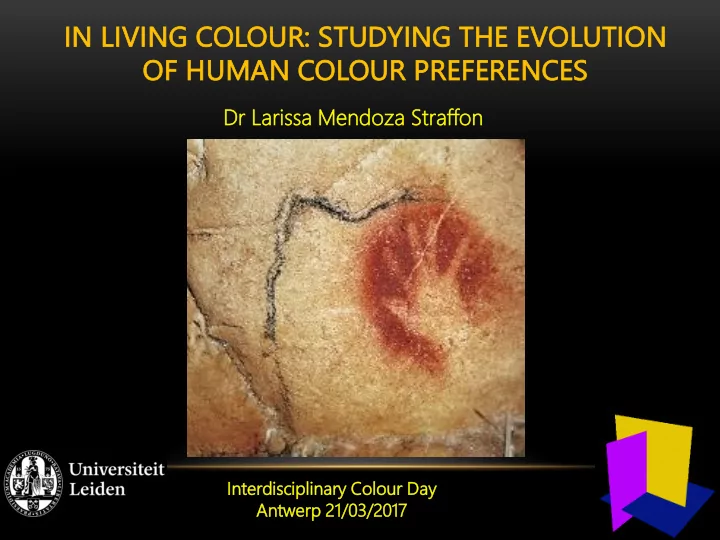

IN LIVING CO COLOUR: STUDYING THE EVOLUTION OF H HUMAN CO COLOUR P PREFERENCES Dr Larissa ssa Mendo doza Straff ffon Inte terdisciplin inary Col Colour Day Day An Antwerp 21/ 21/03/2017
4 QUESTIONS Why do humans have colour vision? Do we all see the same colours? Are colour preferences universal? When did humans start exploiting colour? L MENDOZA STRAFFON - ICA COLOUR DAY
4 QUESTIONS Why do humans have colour vision? Do we all see the same colours? Are colour preferences universal? When did humans start exploiting colour? L MENDOZA STRAFFON - ICA COLOUR DAY
“weapons of of all all kin inds, , mu musical or organs, bri bright col colours an and orna ornamental app appendages, have ave all all bee been indir indirectly gain gained by by the the on one e sex sex or or the the othe other, thr through the the exe exertion of of ch choice, the the inf influence of of lov love an and d jealousy” C. . Dar Darwin, , 1871. 1. Why do humans have colour vision? L MENDOZA STRAFFON - ICA COLOUR DAY
L MENDOZA STRAFFON - ICA COLOUR DAY
Why do humans have colour vision? L MENDOZA STRAFFON - ICA COLOUR DAY
Many different species possess complex colour vision and use colour displays for protection, communication, and attracting mates. Evidence indicates that primate trichromatic colour vision evolved in the context of food detection, and was later co-opted by other behaviours, like mate choice. Human colour vision is an inherited trait from our primate ancestors. L MENDOZA STRAFFON - ICA COLOUR DAY
4 QUESTIONS Why do humans have colour vision? Do we all see the same colours? Are colour preferences universal? When did humans start exploiting colour? L MENDOZA STRAFFON - ICA COLOUR DAY
Most modern languages include 11 ‘basic’ colours: black, white, grey, red, orange, yellow, green, blue, purple, pink, and brown Do we all see the same colours? L MENDOZA STRAFFON - ICA COLOUR DAY
The Yolngu (Australia) do not have a (explicit) distinction for design and colour. Brilliance is the most important property in the Yolngu aesthetic system. The Candoshi (Amazonia) do not seem to have a concept of colour or any colour words. They use comparisons to describe colours, for instance they would use ‘like ripe fruit’ to say red, or ‘like tar’ to mean black. Do we all see the same colours? L MENDOZA STRAFFON - ICA COLOUR DAY
“The Dress” Do we all see the same colours? L MENDOZA STRAFFON - ICA COLOUR DAY
Do we all see the same colours? L MENDOZA STRAFFON - ICA COLOUR DAY
Humans are actually able perceive up to millions of different shades, but these are generally grouped culturally into so- called ‘basic colour’ categories. Perception is not only the result of how sensory data are interpreted by the brain, which may vary among people, but is also influenced by factors like distance, angle, lighting, background, and even the proximity of other colours. Do we all see the same colours? L MENDOZA STRAFFON - ICA COLOUR DAY
4 QUESTIONS Why do humans have colour vision? Do we all see the same colours? Are colour preferences universal? When did humans start exploiting colour? L MENDOZA STRAFFON - ICA COLOUR DAY
www.helpscout.net/blog/psychology-of-color L MENDOZA STRAFFON - ICA COLOUR DAY
Are colour preferences universal? L MENDOZA STRAFFON - ICA COLOUR DAY
Are colour preferences universal? L MENDOZA STRAFFON - ICA COLOUR DAY
There are some cross-cultural similarities regarding the emotional effects of colour. Red, yellow, orange often evoke agitation and stimulation, whereas blue-green give a feeling of focus and calm. These emotional associations might explain that babies seek sensory stimulation, while adults favour calming colours. If colour biases evolved from primate food-seeking behaviour, red-orange colours, associated with ripe fruit, would induce arousal and alertness, whereas green-blue colours reminiscent of foliage and skies might induce rest behaviour. Are colour preferences universal? L MENDOZA STRAFFON - ICA COLOUR DAY
4 QUESTIONS Why do humans have colour vision? Do we all see the same colours? Are colour preferences universal? When did humans start exploiting colour? L MENDOZA STRAFFON - ICA COLOUR DAY
Pinnacle Point, South Africa 160,000 Twin Rivers, Zambia 130,000 Qafzeh Cave, Israel 90,000 Blombos Cave, South Africa 77,000 When did humans start exploiting colour? L MENDOZA STRAFFON - ICA COLOUR DAY
Blombos Cave, SA, 100,000 years When did humans start exploiting colour? L MENDOZA STRAFFON - ICA COLOUR DAY
When did humans start exploiting colour? L MENDOZA STRAFFON - ICA COLOUR DAY
When did humans start exploiting colour? L MENDOZA STRAFFON - ICA COLOUR DAY
L MENDOZA STRAFFON - ICA COLOUR DAY
When did humans start exploiting colour? L MENDOZA STRAFFON - ICA COLOUR DAY
4 QUESTIONS Why do humans have colour vision? Do we all see the same colours? Are colour preferences universal? When did humans start exploiting colour? Some conclusions… L MENDOZA STRAFFON - ICA COLOUR DAY
Colour vision was inherited from our primate ancestors. Humans since their origin have been concerned with ways of incorporating colour into their lives, and beyond. Our species has evolved unique and extraordinary strategies to exploit colour culturally, in many different contexts. Our ancestral interest in colour likely drove the evolution of human aesthetic cognition and artistic behaviour. L MENDOZA STRAFFON - ICA COLOUR DAY
THANK YOU. l.mendoza@hum.leidenuniv.nl
Recommend
More recommend